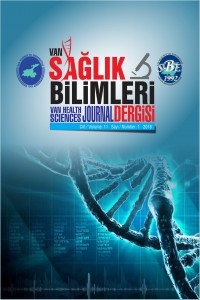Yara iyileşmesinde Kullanılan Çeşitli Materyallerin iyileşme Üzerindeki Etkilerinin Deneysel Olarak Araştırılması
Yara iyileşmesi, kollajen pet (Gelfix), Hidrofilik poliüretan sargı (Allevyn), %1 Silver sülfadiazin krem (Silverdin krem), Steril gazlı bez
The Experimental Study of the Eflects on Healing the Use of Different Material on Wound Healing
Wound healing, Collagen pad (Gelfix), Hydrophilic polyurethane dressing (Allevyn), 1% Silver Sulphadiazine cream (Silverdin cream), Sterile gauze,
___
- Abramo, A.C., Vıola J.C. (1992): Heterologous collagen matrix sponge,histologic and clinical response to its implantation in thrid-degree burn injuries. Br. J. Plastic Surg. 45:117-122.
- Aktaş, E., Patıroğlu, T.E., Soyver, Ü. (1987): Yara iyileşmesinde topikal ilaçların etkisi. VIII. Prof. Dr. A. Lütfü Sempozyumu ICitabı. 128-137.
- Alvarez, O.M., Mertz, P A, Eaglstein, W.H. (1983): The effect of occlusive dressings on collagen synthesis and re-epitheliazation in superficial wounds. J. of Surg. Resear. 35:142-148.
- Armstrong, R.B., Nichols, J., Pachance, J. (1986): Punch biopsv wounds treated wıth Monsel’s solution or a collagenmatrix. Arch. Dermatol. 122:546-549.
- Beghe, F.C., Neggiani, P. (1992): Lyophilizednon- denatured typ 1 collagen(condress) extracted from bovine achilles tendon and suitable for clinical use. Int. J. Tiss. Reac. XIV(suppl)ll-19.
- Breuing, K., Eriksson, E., Lıu. P, Miller, D.R (1992): Healing of partial thickness porcine skin wounds in a liquid environment. J. of Surg. Research. 52:50-58.
- Carrico, T.J., Mehrhof, A.I., Cohen I.K. (1984): Biology of wound healing. Surgical Clin. North America. 64(4)721-731.
- Chvapil, M., Halubec, H. (1991): Inert wound dressing is not desirable. J. Surg. Res. 51: 245-252.
- Chvapil, M., Chvapil, T., Owen, J.A. (1986): Reaction of various skin wounds in the rat to collagen sponge dressing. J. Surg. Res. 41:410-418.
- Ding, Y.L., Han, C.M. (1989): Recentadvences in burn wound managmentin Chine Açta Chir. Plast. 31(2): 84- 91.
- Eaglstein, W.H., Davis, S.C., Mertz, P.M. (1988): Optimal use of an occlusive dressing to enhance healing. Arch. Dermatol. 124:392-395.
- Falanga, V. (1988): Occlusive wound dressing. Arch. Dermatol. 124:872-877.
- Geronemus, R.G., Mertz, P.M., Eaglestein, N.H. (1979): Wound healing:The effects of topical antimicrobial agents. Arch. Dermatol. 115:1311-1317.
- Hammar, H. (1993): Woundhealing. Int. J. Derm. 32(1):6-15.
- Loiterman, D. A, Bayers, P.H. (1991): Effect of a hydrocellular polyurethane dressing on chronic venous ulcer healing. Int. J. Derm. 3(5): 178-181.
- Mc Cauley. R.L., Linares, H.A., Pelligrini. V., Hemdon,D.N. (1989): Invitrotoxicityoftopicalantimicrobial agents to human fıbroblast. J. Surg. Res.46:267-268.
- Mc Cauley, R.L., Yiıng, Yue., Micheal. J.E. (1992): Differential inhibition of human basal keratinocyte growht tosilversulfadiazineandmafenide acetate. J. Surg. Res.52:276-285.
- Mertz, P.M., Eaglstein, M.D. (1984): The effect of a semiocclusive dressing on the microbial population in superfıcial wounds. Arch. Surg. 119:287-289.
- Mian, M., Aloisi, R.. Benetti, D., Rossini, S., Fantozzi, R. (1992): Potential role of heterologous collagen in promoting cutaneous wound repair in rats. Int. J. Tiss. Reac. XIV (suppl): 43-52.
- Mian. M., Begher, F., Mian, E. (1992): Collagen as a pharmacological approach in wound healing. Int. J. Tiss. Reac. XIV(suppl)l:9.
- Mian. E., Martini, P. Beconcini, D., Mian, M. (1992): Healing of öpen skin surfaces with collagen foils. Int. J. Tiss. Reac. XIV(suppl):27-34.
- Palmeri. B. (1992): Heterologous collagen in wound healing: a clinical study. Int. J. Tiss. Reac. XIV(suppl)21-25.
- Regan, M.B., Kırk, S. J., Wasserkrug, H.L., Baıbul, A. (1991): The wound environment as a regülatör of fıbroblast phenotype. J. of Surg. Research. 50(5):442- 448.
- Sawhney. C.P.. Sharma. R.K.. Rao. K.R.. Kaushish, R. (1989): Long-term experience with 1 percent topical silver sulfadiazine cream in the managment of burn wounds. Bums. 15(6):403-406.
- Stern, H.S. (1989): Silver sulphadiazine and the healing of partial thickness burns; a prospective clinical trial. Br. J. Plast. Surg. 42(5):581-585.
- Watcher, M. A., Wheeland, RG. (1989): The role of topical agents in the healing of full-thickness wounds. J. Dermatology Surg. Oncol. 15(11): 1188-1195.
- ISSN: 2667-5072
- Başlangıç: 2018
- Yayıncı: Van Yüzüncü Yıl Üniversitesi
Van ve Yöresinde Koç Orşitleri Üzerinde Çalışmalar
Bahtiyar BAKIR, Fethi GÜLYÜZ, Banur BOYNUKARA, İsmail ALKAN
Kıvırcık Irkı Koçlarda Dölverimi Özellikleri
Serbest Radikal Türlerinin Membran Lipid Peroksidasyonuna Etkileri ve Hücresel Antioksidan Savunma
Recep ASLAN, Mehmet Ramazan ŞEKEROĞLU, Fahir BAYIROĞLU
Köpeklerde Metritis ve Pyometritis
Mehmet Ragıp KILIÇARSLAN, Adem ŞENÜNVER, Huriye HOROZ, İsmail KIRŞAN, Cengiz S. KONUK, Figen TAVUKÇUOĞLU
Van Gölü Suyuna Gökkuşağı Alabalığı (Oncorhynchus mykiss W. 1792) Adaptasyonu Üzerine Bir Araştırma
Mustafa BERKTAŞ, Banur BOYNUKARA, İclal BALCI, Hamza BOZKURT, Tevfik YAVUZ, Enes DALKILIÇ
Açık Kırıklarda Antibiyotiklerin Seçimi ve Tedavi Süresi
Koyunlarda Endometritis Üzerine Araştırmalar
Fetih GÜLYÜZ, Banur BOYNUKARA, Kemal GÜRTÜRK, Ziya İLHAN, Burhanettin BAYDAŞ
Atilla KAYA, Hasan BİLGİLİ, Burhanettin OLCAY, Yılmaz AYDIN
Van Piyasasında Tüketime Sunulan Et ve Et Ürünlerinde Sarcosporidiosis’in Yayılışı
